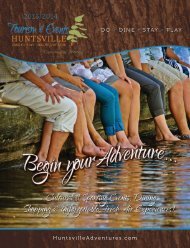Download Visitor Guide - Huntsville Adventures
Download Visitor Guide - Huntsville Adventures
Download Visitor Guide - Huntsville Adventures
Create successful ePaper yourself
Turn your PDF publications into a flip-book with our unique Google optimized e-Paper software.
Muskoka Heritage Foundation<br />
I am sure that if asked to name an animal evocative of this area, frogs,<br />
toads and salamanders would not be named... too bad because they<br />
are a fascinating and underappreciated component of our natural<br />
environment here!<br />
Frogs, toads and salamanders are amphibians, a group of coldblooded<br />
animals which lay eggs and are characterized by moist skin.<br />
They absorb water and oxygen through their skin, although most<br />
use lungs as well. They are referred to as having “two lives” because<br />
they are completely aquatic as tadpoles and terrestrial as adults.<br />
In this part of Ontario, we have<br />
10 species of frogs and toads and 7<br />
species of salamanders. This low species<br />
diversity is because only those species<br />
able to hibernate through our long<br />
freezing winters are able to survive here.<br />
In the True Frog family, common<br />
local species include the ubiquitous<br />
wood frog, northern leopard frog,<br />
green frog and bullfrog. Wood frogs<br />
are often called “robber” frogs because<br />
they have a black mask across their<br />
eyes. Green frogs can be confused<br />
with bullfrogs except that bullfrogs<br />
are much larger and green frogs have<br />
folds down their backs. The call of<br />
Muskoka Heritage<br />
Foundation<br />
adult bullfrogs, which sounds like “jug-of-rum,” is commonly heard<br />
throughout the summer. Uncommon True Frogs include pickerel and<br />
mink frogs.<br />
The Tree Frog group includes spring peepers, gray treefrog and<br />
western chorus frog. This group of frogs is interesting because they<br />
have discs on the tips of their toes which allow them to climb vertical<br />
surfaces. Gray treefrogs may be found at night clinging to an outside<br />
wall near a light, feasting on the insects attracted there. Spring peepers<br />
are aptly named as they congregate at ponds in the early spring even<br />
before the ice is gone, where the males emit their distinctive earpiercing<br />
peeps.<br />
We are all familiar with our only species of toad – the American<br />
toad. Toads can live quite happily near our homes and gardens, where<br />
they find their favourite foods: insects, slugs and worms. Toads are a<br />
preferred food of an at-risk reptile, the eastern hog-nosed snake.<br />
My youngest daughter used to refer to rotten logs in the forest as<br />
salamanders because that is what we turned over to find them. Blue-<br />
[ By Jan McDonnell ]<br />
spotted and spotted (which have yellow spots) salamanders are<br />
common but secretive as they are both nocturnal and spend much<br />
of their time in leaf litter or, as mentioned, in rotten logs. Another<br />
group of salamanders found in our area are called lungless and for<br />
good reason – adults have no lungs but get oxygen through their<br />
moist skins. Northern two-toed, four-toed and eastern red-backed<br />
salamanders are locally found as well.<br />
Eastern newt and mudpuppies are also part of the salamander<br />
family. Newts are interesting because adults of this species return to<br />
the water after a terrestrial juvenile<br />
stage. The juveniles are called efts and<br />
the loss of forests and<br />
are bright red. Mudpuppies are the<br />
wetlands is substantial in largest salamander in Canada and live<br />
many parts of the world in deep water habitats.<br />
We can’t have a discussion about<br />
amphibians without mentioning global<br />
declines. Habitat loss is an important<br />
reason – the loss of forests and<br />
wetlands is substantial in many parts<br />
of the world. Chemical contaminants<br />
cause deformities and other problems.<br />
Climate change contributes because<br />
amphibians are so sensitive to small<br />
changes in temperature and moisture;<br />
destruction of the ozone layer results<br />
in the increased UV radiation which is harmful to amphibians.<br />
Globally, it is thought that 1/3 of the world’s species are threatened<br />
and extinctions within the last 20 years have been rampant.<br />
So what can we do about this issue? I recommend learning<br />
more about it. The internet is an obvious source and there are<br />
some excellent books out there, including The ROM Field <strong>Guide</strong> to<br />
Amphibians and Reptiles of Ontario. Become an advocate for habitat<br />
protection – even tiny wetlands can provide habitat for a variety of<br />
species. Lastly, start learning more about climate change to figure out<br />
ways to reduce your footprint.<br />
For 24 years, the Muskoka Heritage Foundation has<br />
protected, conserved and nurtured the area’s natural<br />
and cultural environment for the benefit of future<br />
generations. You can help us conserve Muskoka’s<br />
environment: become a member, make a donation,<br />
leave a legacy. For more info contact 705-645-7393 ext.<br />
200 or visit www.muskokaheritage.org<br />
WWW.HUNTSVILLEADVENTURES.COM • 2012/13 VISITORS GUIDE 37



